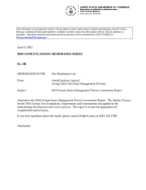2010 Census Issues Management Process Assessment Report
2010 Census Issues Management Process Assessment Report
Executive Summary
This document is an analysis and assessment of the formal 2010 Census Issues Management process and how it was used to manage issues that arose during the U.S. Census Bureau‘s efforts to prepare and implement the 2010 Census. The conclusions from this assessment are derived chiefly from the comments of people w ho worked on that census program.
The 2010 Census program defined an issue as a point or matter in question or in dispute, or a point or matter that is not settled and is under discussion or over which there are opposing views or disagreements. Issues may occur when no strategy exists to achieve objectives, when essential information is not communicated effectively, or when unanticipated events occur which require plans to be changed. Some issues result from known risks that are realized despite efforts to prevent and mitigate them. Issues were escalated to the program level for resolution from integrated project teams following specific criteria that were outlined in the 2010 Census Issues Management Plan.
Decennial program-integrated project teams were resourceful in dealing with issues, which resulted in a census that ended on time and below budget. The issues management process instituted for the 2010 Census outlined the methodologies used by teams to achieve resolution of issues at the program level, including the escalation of issues, when appropriate. Although an assessment of issues management at the project level was not in scope for this assessment, a lesson learned for the 2020 Census program is to gather more information about how project teams dealt with project issues. This knowledge may provide a means to better deal with future issues as they occur, and a clearer understanding of their nature.
Issues management was not formally implemented in the 2010 Census process until 2006, and little record remains of the issues that teams ha d to engage during the planning years (prior to 2006). This lack of historical accounting diminished management’s ability to effectively assess risks and allocate resources, and diminished the agency’s ability to identify patterns that might lead to better methodologies and avoid future issues.
This assessment advocates early planning informed by subject matter experts and regular inter- team exchanges to prevent conditions that can le ad to issues. It advocates strategies that maximize enthusiastic engagement with sanctioned policies and practices by returning benefits to the persons who have been given the responsibility to resolve issues.
This assessment recommends the following actions for managing issues during the 2020 Census program:
- Start planning efforts early in order to have a well-established process early in the decade that addresses both project-level and program-level (“Key”) issues management.
- Provide integrated project teams with training to help team member s recognize risks that are becoming issues and familiarize them with issue escalation procedures.
- Improve integration of issues management with the related risk and change management processes, and integrate issues management planning with governance planning to ensure clear roles and responsibilities are documented so that issues are resolved.
- Install issues management software that facilitates communication, records issue characteristics and process events, provides direct access for users, permits categorically retrievable data, and facilitates timely sharing of current issues statuses.
- Implement a simple automated tool to make it possible for project teams to better manage their own issues.
- Produce regular issues metric reports and ensure that governance plans include a process for issue status reviews.
- Improve integrated team communication structures to facilitate the sharing of technical information between teams when they are working on common issues.
- Assign an issues manager for each project team to monitor and record issues, and serve as a point of contact for the program-level issues manager.
- Provide issue process facilitators as resources to teams who can help accelerate access to issue decision makers and help assure that issues are well documented.
- Analyze past issues data to discern patterns of risks and conditions that have led to issues.
- Enlist team member input to better tailor issue-relate d services to their perceived needs.
- Establsih a quality control process to continually monitor the management of issues.
Others in Series
Publication
Publication
Publication






